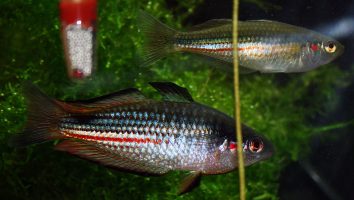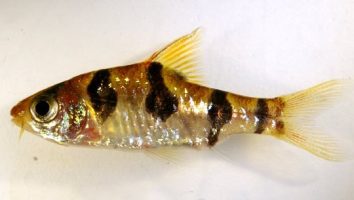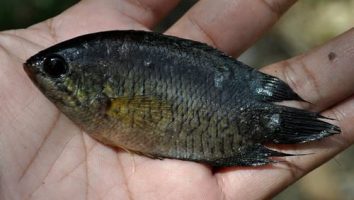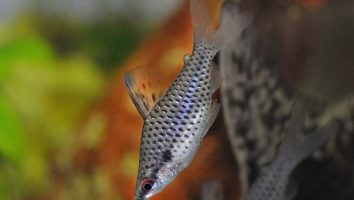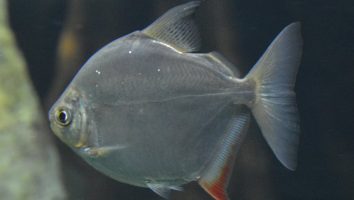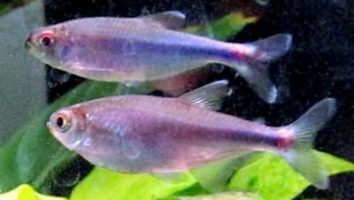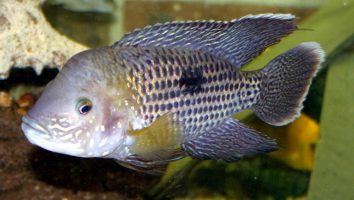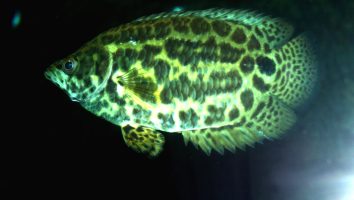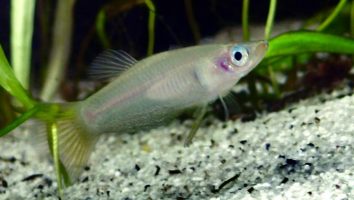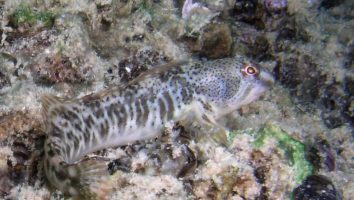Malabar Danios are a schooling fish that are native to India.
They’re a peaceful fish that are perfect for beginner aquarium hobbyists.
But even though they’re easy to care for, there are still a few things you need to know to ensure they have a long and happy life.
This guide will teach you everything you need to know about Malabar Danio care. We’ll go over their diet, tank mates, lifespan, and more!
Table of contents
Species overview
Malabar Danios (Danio malabaricus) are a freshwater fish that is native to the Western Ghats mountain range in India.
They prefer slow-moving waters with a lot of vegetation, and they are often found in schools near the surface of the water.
Malabar Danios are omnivores, and in the wild, they eat a diet of small insects, crustaceans, and plant matter.
These fish are very popular in the aquarium trade, and they are often kept in community tanks. They are peaceful fish that do well with a variety of different tank mates.
Appearance
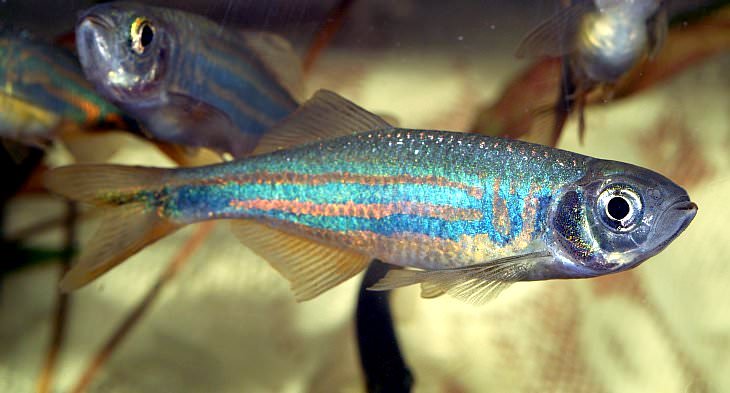
The Malabar danio is a very striking freshwater fish that is sure to catch your eye. They have a very bright and vibrant coloration that is a mix of blue, green, and purple.
The blue coloration is usually on their dorsal half, while the green and purple are on their ventral half. There is also a black stripe that runs from their mouth all the way to the base of their tail. This stripe is pretty thin and is bordered by a thin line of white.
The Malabar danio has a very long and thin body shape that tapers off at the end. They have a long dorsal fin that starts about two-thirds of the way back on their body. This fin has a lot of rays in it and extends all the way to the end of their tail.
Their anal fin is much shorter and starts closer to the front of their bodies. Both of these fins are transparent with a hint of color.
The caudal fin is forked and symmetrical. The Malabar danio also has a pair of small pectoral fins.
Lifespan
The Malabar danio has a lifespan of about 3 years in captivity. The average lifespan in the wild is unknown but is likely to be shorter due to predation and other risks.
As with any fish, there are a number of factors that can impact the lifespan of Malabar danios. These include things like water quality, diet, and stress.
That said, these are generally very hardy fish and as long as they’re well cared for, they should have no problem living to their full potential.
Size
The Malabar Danio is a small freshwater fish that only grows to be about 2.5 inches in length. However, they are a very active and lively fish that do best in groups. As a result, you will need a larger tank if you want to keep a school of these fish.
Tank
Tank Size
The minimum tank size for Malabar Danios is 10 gallons. If you’re looking for a freshwater fish that can fit in an average-sized tank, this is the fish for you.
You can keep more than one Malabar Danios in the same tank but you will need to add at least another 5 gallons per fish.
Another reason why you need to provide enough space is for the sake of enrichment and comfort. These fish like to roam and will often run gentle but steady laps around your tank. Giving them a little bit of extra space can go a long way in making sure they can comfortably turn around in the tank.
Water Parameters
Danio malabaricus is a tropical fish that comes from the Western Ghats mountain range in India. In their natural habitat, they reside in streams with a moderate to high flow rate and plenty of rocks and vegetation.
To recreate this environment in your aquarium, you’ll need to maintain similar water parameters.
- Water Temperature: 72 to 80 degrees Fahrenheit
- pH Levels: 6.5 to 7.5
- Water Hardness: 5 to 15 dGH
- Alkalinity Levels: 3 to 8 dKH
What To Put In Their Tank
Malabar Danios are a schooling fish, so you’ll need to have at least 6 of them in your tank. They’re also a very active fish, so you’ll need to provide them with plenty of space to swim.
We recommend a tank size of at least 20 gallons for a school of 6 Malabar Danios. If you can provide them with more space, then that’s even better.
As for the inside of the tank, these fish don’t have any specific requirements. You can use gravel, sand, or even go with a bare-bottom tank if you want.
Plants are always a nice addition to any aquarium, but be aware that Malabar Danios are known to nibble on them. If you do decide to go with plants, choose something that can withstand a little bit of abuse (like hornwort or water wisteria).
As for other decorations, it’s really up to you. Rocks, driftwood, and caves are all suitable choices. Just make sure there are plenty of places for your fish to hide and feel secure.
Common Diseases
Malabar Danios are a pretty hardy and disease-resistant fish. However, they are still susceptible to the same illnesses that affect other freshwater fish.
The most common disease that these fish experience is ich. This is a parasite that will attach itself to your fish and cause white spots to form on their body.
If left untreated, ich can be fatal. However, it is relatively easy to treat with the proper medication.
Another disease that Malabar Danios are prone to is fin rot. This is an infection that will eat away at the fins of your fish, and it is usually caused by poor water quality.
If you notice that your fish’s fins are looking ragged or torn, it’s important to take action immediately. Fin rot is relatively easy to treat if it’s caught early, but it can be fatal if it’s left untreated.
The best way to prevent these diseases is to maintain a high quality of water in your tank. A clean and stable environment will go a long way in keeping your fish healthy and disease-free.
Behavior & Temperament
Malabar Danios are very peaceful fish that do well in community tanks. They are known for being active swimmers and will often swim in large schools.
While they are peaceful fish, they can be a little nippy. They may nip at the fins of other fish or even decorations in the tank. This is usually more of a problem when they are kept in smaller tanks.
Other than that, they are relatively easy to care for and make a great addition to any community tank!
Tank Mates
Malabar Danios are schooling fish, so they should be kept in groups of at least 6. They are peaceful fish that get along with most other community fish.
Some compatible fish include:
- Neon Tetras
- Guppies
- Mollies
- Platies
- Swordtails
- Angelfish
- Bristlenose Plecos
- Cherry Shrimp
- Ghost Shrimp
Breeding
The Malabar danio is a beautiful and unique-looking fish that’s native to India. They’re not the easiest fish to breed in captivity, but it can be done with some patience and effort.
As with most fish, the first step is to sex them. Males and females have some subtle differences in their appearance. For starters, males are usually a bit larger. They also have longer fins, especially the dorsal fin.
The easiest way to tell them apart is by their coloration. Males are much brighter and more colorful. Their patterns are also more distinct. Females, on the other hand, are duller in color. Their patterns are also less defined.
Once you’ve sexed your fish, you can start setting up the breeding tank. The tank should be at least 30 gallons in size. It should also have a good amount of vegetation.
Malabar danios like to lay their eggs in plant beds, so the more plants you have, the better. Indian Almond Leaves are a good option. You can also use Java Moss or Java Fern.
The water should be soft and slightly acidic. Aim for a pH of 6.5. The temperature should be between 74 and 82 degrees Fahrenheit.
When everything is ready, add a group of five or six fish to the tank. The ratio of males to females should be 2:1.
The fish will start to breed on their own, but you can help to trigger spawning by doing water changes. A 50 percent water change should do the trick.
Once the female lays her eggs, the male will fertilize them. The eggs will hatch in about 24 hours.
The fry are very small and delicate, so they need to be fed properly. Give them live foods like brine shrimp or daphnia. You can also use a quality fry food.
Feed them several times a day, but don’t overdo it. A good rule of thumb is to give them as much food as they can eat in five minutes.
Conclusion
The Malabar Danio is a great freshwater fish for beginner aquarists. They’re easy to care for and are very peaceful, making them a great addition to community tanks.
They’re also very active and have a lot of personality, which we think is a big plus.
Overall, we think the Malabar Danio is a great choice for anyone looking for a low-maintenance fish that will still add some excitement to their tank!

